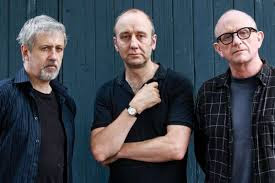One of the best albums I heard in this re-listening experience is the album of this collaboration of some amazing artists under the name 'Death Ambient'. I was very impressed by the first time I bought it more than 10 years ago, but since then I was able to listen more of Ikue Mori, Fred Frith, and Kato Hideki, who are the main members of the Drunken Forest orchestra.
This album was released in Tzadik in 2007. It was the year I finished my military service and I was opening my ears to more experimental and electroacoustic music, such as Annie Gosfield, Sylvie Courvoisier, and also spending a lot of time listening to some of the great musicians of electronic music, such as PanSonic, Aphex Twin, Autechre and releases from Raster Noton. Also, it was time that I was trying to understand better the term of ambient music, and this was supposed to be an ambient music release, which made me even more confused about its definition.
Listening again this album I'm not sure if it is a release or actually thinking of a performance or a collection of sounds and the techniques around them. 'Lake Chad' is a great intro, giving space to the musicians to show and identify their role in the album. Without much interaction between them, it feels like an opening for the artists to introduce what type of instruments and sounds they'll play during the album. 'Greenhouse' starts with Ikue Mori' sound effects and then peaks up gradually with Frith's string playing and electronics until it becomes less tense.
'Cocktail of Chemicals' is my favourite track of the album. Starts with a violin and Frith's guitar slow playing, and preparing the listener for something great. And this is again some electronic sounds, much more powerful and covering Frith's playing that is more like listening to the background. Sounding like a sudden injection going inside you, blurring the brain and the neurons, making you feel muted and giving body spasms. Even the sound in the ears at the end of the track is kind of echoic and muted.
'Thermocaline', is another example of the great sound explorations and the interchange between sound recordings, strings and natural sounds that reaches its graduals peak as the composition reaches to the end of the track. 'Dead Zone' is a bit different leaving a lot of space to the electronics and less on the musical instruments. To the listener, it feels like exploring an unknown and unfamiliar place that can imagine only by freeing the auditory senses. Like walking in a strange and abandoned land.
The remaining of the album is based a lot on the sound effects creating an airy space and what is missing is the outburst and the presence of string instruments, that are now moved to more like percussions, accompanying the mixes and sound recordings. The titles of the tracks and of course the name of the band have a strong influence by the elements of nature, but close to its destruction or at best its gradual deterioration. The second half of the album could be said that sounds more like to this degradation and the slow pace, less intense and presence of cello make a strong statement to this. As the album gets close to the end although it sounds like there more improvisation and percussion instruments, the 'Drunken Forest' track of the album is possibly the only track that follows a more particular melodic pattern, and not so much experimenting or improvising.
Inside the leaflet of the cd case, it refers to 'Opening your ears in a striking new world', and it is a very good description of this release. This album is definitely something that everyone should listen to. Whether as a study on sound effects and experimental composition or just using it as a score in a video, movie etc. It is definitely a masterpiece and the artists that are part of the Death Ambient leave their creative mark.















